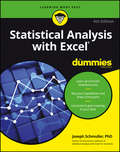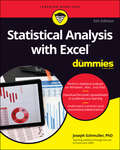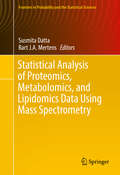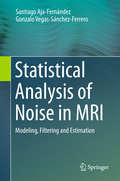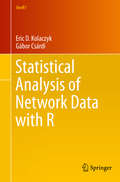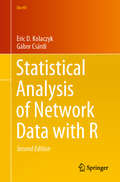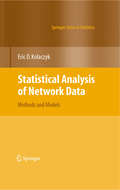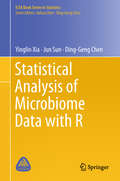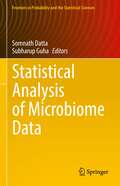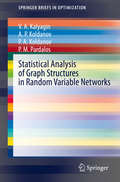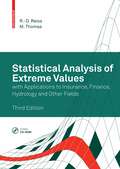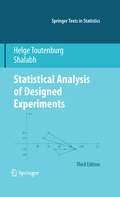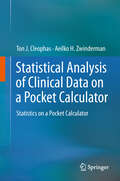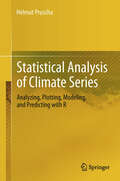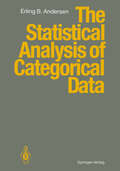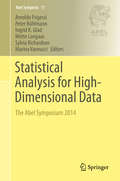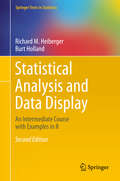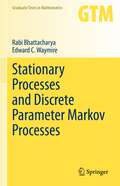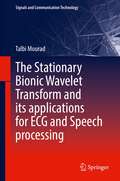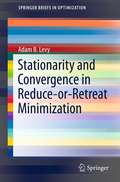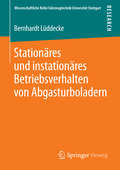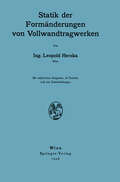- Table View
- List View
Statistical Analysis with Excel For Dummies
by Joseph SchmullerThere's nothing random about it—this is the book on statistical analysis with Excel Stunned by statistics? Exhausted by Excel? Relax! Statistical Analysis with Excel For Dummies, 4th Edition shows you how to use the world's most popular spreadsheet program to crunch numbers and interpret statistics—even if you've never taken a statistics or advanced math course. In no time, you'll learn to use Excel to create and translate statistics in everyday life, understand common statistical terms, and improve your classroom or professional skills. Statistics has a reputation for being a challenging, math-intensive pursuit—but it doesn't have to make your palms sweat. Using a minimum of equations and assuming no prior knowledge of statistics or Excel, this hands-on guide cuts through the jargon and shows you how to make sense of formulas and functions, charts and PivotTables, samples and normal distributions, probabilities and related distributions, trends and correlations, and much more. Use Excel's tools to analyze and understand data Apply statistical analysis to predict trends and make decisions Interpret sales figures, gambling odds, and sports stats Develop a grading curve or medical correlations Forget the mumbo jumbo! This guide shows you that statistical analysis with Excel can be easy, fun, and useful!
Statistical Analysis with Excel For Dummies
by Joseph SchmullerThere's nothing random about it—this is the book on statistical analysis with Excel Stunned by statistics? Exhausted by Excel? Relax! Statistical Analysis with Excel For Dummies, 4th Edition shows you how to use the world's most popular spreadsheet program to crunch numbers and interpret statistics—even if you've never taken a statistics or advanced math course. In no time, you'll learn to use Excel to create and translate statistics in everyday life, understand common statistical terms, and improve your classroom or professional skills. Statistics has a reputation for being a challenging, math-intensive pursuit—but it doesn't have to make your palms sweat. Using a minimum of equations and assuming no prior knowledge of statistics or Excel, this hands-on guide cuts through the jargon and shows you how to make sense of formulas and functions, charts and PivotTables, samples and normal distributions, probabilities and related distributions, trends and correlations, and much more. Use Excel's tools to analyze and understand data Apply statistical analysis to predict trends and make decisions Interpret sales figures, gambling odds, and sports stats Develop a grading curve or medical correlations Forget the mumbo jumbo! This guide shows you that statistical analysis with Excel can be easy, fun, and useful!
Statistical Analysis with Excel For Dummies
by Joseph SchmullerBecome a stats superstar by using Excel to reveal the powerful secrets of statistics Microsoft Excel offers numerous possibilities for statistical analysis—and you don’t have to be a math wizard to unlock them. In Statistical Analysis with Excel For Dummies, fully updated for the 2021 version of Excel, you’ll hit the ground running with straightforward techniques and practical guidance to unlock the power of statistics in Excel. Bypass unnecessary jargon and skip right to mastering formulas, functions, charts, probabilities, distributions, and correlations. Written for professionals and students without a background in statistics or math, you’ll learn to create, interpret, and translate statistics—and have fun doing it! In this book you’ll find out how to: Understand, describe, and summarize any kind of data, from sports stats to sales figures Confidently draw conclusions from your analyses, make accurate predictions, and calculate correlations Model the probabilities of future outcomes based on past data Perform statistical analysis on any platform: Windows, Mac, or iPad Access additional resources and practice templates through Dummies.com For anyone who’s ever wanted to unleash the full potential of statistical analysis in Excel—and impress your colleagues or classmates along the way—Statistical Analysis with Excel For Dummies walks you through the foundational concepts of analyzing statistics and the step-by-step methods you use to apply them.
Statistical Analysis with Excel For Dummies
by Joseph SchmullerBecome a stats superstar by using Excel to reveal the powerful secrets of statistics Microsoft Excel offers numerous possibilities for statistical analysis—and you don’t have to be a math wizard to unlock them. In Statistical Analysis with Excel For Dummies, fully updated for the 2021 version of Excel, you’ll hit the ground running with straightforward techniques and practical guidance to unlock the power of statistics in Excel. Bypass unnecessary jargon and skip right to mastering formulas, functions, charts, probabilities, distributions, and correlations. Written for professionals and students without a background in statistics or math, you’ll learn to create, interpret, and translate statistics—and have fun doing it! In this book you’ll find out how to: Understand, describe, and summarize any kind of data, from sports stats to sales figures Confidently draw conclusions from your analyses, make accurate predictions, and calculate correlations Model the probabilities of future outcomes based on past data Perform statistical analysis on any platform: Windows, Mac, or iPad Access additional resources and practice templates through Dummies.com For anyone who’s ever wanted to unleash the full potential of statistical analysis in Excel—and impress your colleagues or classmates along the way—Statistical Analysis with Excel For Dummies walks you through the foundational concepts of analyzing statistics and the step-by-step methods you use to apply them.
Statistical Analysis of Proteomics, Metabolomics, and Lipidomics Data Using Mass Spectrometry (Frontiers in Probability and the Statistical Sciences)
by Susmita Datta Bart J. MertensThis book presents an overview of computational and statistical design and analysis of mass spectrometry-based proteomics, metabolomics, and lipidomics data. This contributed volume provides an introduction to the special aspects of statistical design and analysis with mass spectrometry data for the new omic sciences. The text discusses common aspects of design and analysis between and across all (or most) forms of mass spectrometry, while also providing special examples of application with the most common forms of mass spectrometry. Also covered are applications of computational mass spectrometry not only in clinical study but also in the interpretation of omics data in plant biology studies.Omics research fields are expected to revolutionize biomolecular research by the ability to simultaneously profile many compounds within either patient blood, urine, tissue, or other biological samples. Mass spectrometry is one of the key analytical techniques used in these new omic sciences. Liquid chromatography mass spectrometry, time-of-flight data, and Fourier transform mass spectrometry are but a selection of the measurement platforms available to the modern analyst. Thus in practical proteomics or metabolomics, researchers will not only be confronted with new high dimensional data types—as opposed to the familiar data structures in more classical genomics—but also with great variation between distinct types of mass spectral measurements derived from different platforms, which may complicate analyses, comparison, and interpretation of results.
Statistical Analysis of Noise in MRI: Modeling, Filtering and Estimation
by Santiago Aja-Fernández Gonzalo Vegas-Sánchez-FerreroThis unique text presents a comprehensive review of methods for modeling signal and noise in magnetic resonance imaging (MRI), providing a systematic study, classifying and comparing the numerous and varied estimation and filtering techniques. Features: provides a complete framework for the modeling and analysis of noise in MRI, considering different modalities and acquisition techniques; describes noise and signal estimation for MRI from a statistical signal processing perspective; surveys the different methods to remove noise in MRI acquisitions from a practical point of view; reviews different techniques for estimating noise from MRI data in single- and multiple-coil systems for fully sampled acquisitions; examines the issue of noise estimation when accelerated acquisitions are considered, and parallel imaging methods are used to reconstruct the signal; includes appendices covering probability density functions, combinations of random variables used to derive estimators, and useful MRI datasets.
Statistical Analysis of Network Data with R (Use R! #65)
by Eric D. Kolaczyk Gábor CsárdiNetworks have permeated everyday life through everyday realities like the Internet, social networks, and viral marketing. As such, network analysis is an important growth area in the quantitative sciences, with roots in social network analysis going back to the 1930s and graph theory going back centuries. Measurement and analysis are integral components of network research. As a result, statistical methods play a critical role in network analysis. This book is the first of its kind in network research. It can be used as a stand-alone resource in which multiple R packages are used to illustrate how to conduct a wide range of network analyses, from basic manipulation and visualization, to summary and characterization, to modeling of network data. The central package is igraph, which provides extensive capabilities for studying network graphs in R. This text builds on Eric D. Kolaczyk’s book Statistical Analysis of Network Data (Springer, 2009).
Statistical Analysis of Network Data with R (Use R! #65)
by Eric D. Kolaczyk Gábor CsárdiThe new edition of this book provides an easily accessible introduction to the statistical analysis of network data using R. It has been fully revised and can be used as a stand-alone resource in which multiple R packages are used to illustrate how to conduct a wide range of network analyses, from basic manipulation and visualization, to summary and characterization, to modeling of network data. The central package is igraph, which provides extensive capabilities for studying network graphs in R. The new edition of this book includes an overhaul to recent changes in igraph. The material in this book is organized to flow from descriptive statistical methods to topics centered on modeling and inference with networks, with the latter separated into two sub-areas, corresponding first to the modeling and inference of networks themselves, and then, to processes on networks. The book begins by covering tools for the manipulation of network data. Next, it addresses visualization and characterization of networks. The book then examines mathematical and statistical network modeling. This is followed by a special case of network modeling wherein the network topology must be inferred. Network processes, both static and dynamic are addressed in the subsequent chapters. The book concludes by featuring chapters on network flows, dynamic networks, and networked experiments. Statistical Analysis of Network Data with R, 2nd Ed. has been written at a level aimed at graduate students and researchers in quantitative disciplines engaged in the statistical analysis of network data, although advanced undergraduates already comfortable with R should find the book fairly accessible as well.
Statistical Analysis of Network Data: Methods and Models (Springer Series in Statistics)
by Eric D. KolaczykIn recent years there has been an explosion of network data – that is, measu- ments that are either of or from a system conceptualized as a network – from se- ingly all corners of science. The combination of an increasingly pervasive interest in scienti c analysis at a systems level and the ever-growing capabilities for hi- throughput data collection in various elds has fueled this trend. Researchers from biology and bioinformatics to physics, from computer science to the information sciences, and from economics to sociology are more and more engaged in the c- lection and statistical analysis of data from a network-centric perspective. Accordingly, the contributions to statistical methods and modeling in this area have come from a similarly broad spectrum of areas, often independently of each other. Many books already have been written addressing network data and network problems in speci c individual disciplines. However, there is at present no single book that provides a modern treatment of a core body of knowledge for statistical analysis of network data that cuts across the various disciplines and is organized rather according to a statistical taxonomy of tasks and techniques. This book seeks to ll that gap and, as such, it aims to contribute to a growing trend in recent years to facilitate the exchange of knowledge across the pre-existing boundaries between those disciplines that play a role in what is coming to be called ‘network science.
Statistical Analysis of Microbiome Data with R (ICSA Book Series in Statistics)
by Yinglin Xia Jun Sun Ding-Geng ChenThis unique book addresses the statistical modelling and analysis of microbiome data using cutting-edge R software. It includes real-world data from the authors’ research and from the public domain, and discusses the implementation of R for data analysis step by step. The data and R computer programs are publicly available, allowing readers to replicate the model development and data analysis presented in each chapter, so that these new methods can be readily applied in their own research. The book also discusses recent developments in statistical modelling and data analysis in microbiome research, as well as the latest advances in next-generation sequencing and big data in methodological development and applications. This timely book will greatly benefit all readers involved in microbiome, ecology and microarray data analyses, as well as other fields of research.
Statistical Analysis of Microbiome Data (Frontiers in Probability and the Statistical Sciences)
by Somnath Datta Subharup GuhaMicrobiome research has focused on microorganisms that live within the human body and their effects on health. During the last few years, the quantification of microbiome composition in different environments has been facilitated by the advent of high throughput sequencing technologies. The statistical challenges include computational difficulties due to the high volume of data; normalization and quantification of metabolic abundances, relative taxa and bacterial genes; high-dimensionality; multivariate analysis; the inherently compositional nature of the data; and the proper utilization of complementary phylogenetic information. This has resulted in an explosion of statistical approaches aimed at tackling the unique opportunities and challenges presented by microbiome data. This book provides a comprehensive overview of the state of the art in statistical and informatics technologies for microbiome research. In addition to reviewing demonstrably successful cutting-edge methods, particular emphasis is placed on examples in R that rely on available statistical packages for microbiome data. With its wide-ranging approach, the book benefits not only trained statisticians in academia and industry involved in microbiome research, but also other scientists working in microbiomics and in related fields.
Statistical Analysis of Graph Structures in Random Variable Networks (SpringerBriefs in Optimization)
by V. A. Kalyagin A. P. Koldanov P. A. Koldanov P. M. PardalosThis book studies complex systems with elements represented by random variables. Its main goal is to study and compare uncertainty of algorithms of network structure identification with applications to market network analysis. For this, a mathematical model of random variable network is introduced, uncertainty of identification procedure is defined through a risk function, random variables networks with different measures of similarity (dependence) are discussed, and general statistical properties of identification algorithms are studied. The volume also introduces a new class of identification algorithms based on a new measure of similarity and prove its robustness in a large class of distributions, and presents applications to social networks, power transmission grids, telecommunication networks, stock market networks, and brain networks through a theoretical analysis that identifies network structures. Both researchers and graduate students in computer science, mathematics, and optimization will find the applications and techniques presented useful.
Statistical Analysis of Extreme Values: with Applications to Insurance, Finance, Hydrology and Other Fields
by Rolf-Dieter Reiss Michael ThomasStatistical analysis of extreme data is vital to many disciplines including hydrology, insurance, finance, engineering and environmental sciences. This book provides a self-contained introduction to parametric modeling, exploratory analysis and statistical interference for extreme values. For this Third Edition, the entire text has been thoroughly updated and rearranged to meet contemporary requirements, with new sections and chapters address such topics as dependencies, the conditional analysis and the multivariate modeling of extreme data. New chapters include An Overview of Reduced-Bias Estimation; The Spectral Decomposition Methodology; About Tail Independence; and Extreme Value Statistics of Dependent Random Variables.
Statistical Analysis of Designed Experiments, Third Edition (Springer Texts in Statistics)
by Helge Toutenburg ShalabhThis book is the third revised and updated English edition of the German textbook \Versuchsplanung und Modellwahl" by Helge Toutenburg which was based on more than 15 years experience of lectures on the course \- sign of Experiments" at the University of Munich and interactions with the statisticians from industries and other areas of applied sciences and en- neering. This is a type of resource/ reference book which contains statistical methods used by researchers in applied areas. Because of the diverse ex- ples combined with software demonstrations it is also useful as a textbook in more advanced courses, The applications of design of experiments have seen a signi?cant growth in the last few decades in di?erent areas like industries, pharmaceutical sciences, medical sciences, engineering sciences etc. The second edition of this book received appreciation from academicians, teachers, students and applied statisticians. As a consequence, Springer-Verlag invited Helge Toutenburg to revise it and he invited Shalabh for the third edition of the book. In our experience with students, statisticians from industries and - searchers from other ?elds of experimental sciences, we realized the importance of several topics in the design of experiments which will - crease the utility of this book. Moreover we experienced that these topics are mostly explained only theoretically in most of the available books.
Statistical Analysis of Clinical Data on a Pocket Calculator: Statistics on a Pocket Calculator
by Ton J. Cleophas Aeilko H. ZwindermanThe core principles of statistical analysis are too easily forgotten in today’s world of powerful computers and time-saving algorithms. This step-by-step primer takes researchers who lack the confidence to conduct their own analyses right back to basics, allowing them to scrutinize their own data through a series of rapidly executed reckonings on a simple pocket calculator. A range of easily navigable tutorials facilitate the reader’s assimilation of the techniques, while a separate chapter on next generation Flash prepares them for future developments in the field. This practical volume also contains tips on how to deny hackers access to Flash internet sites. An ideal companion to the author’s co-authored works on statistical analysis for Springer such as Statistics Applied to Clinical Trials, this monograph will help researchers understand the processes involved in interpreting clinical data, as well as being a necessary prerequisite to mastering more advanced statistical techniques. The principles of statistical analysis are easily forgotten in today’s world of time-saving algorithms. This step-by-step primer takes researchers back to basics, enabling them to examine their own data through a series of sums on a simple pocket calculator.
Statistical Analysis of Climate Series: Analyzing, Plotting, Modeling, and Predicting with R
by Helmut PruschaThe book presents the application of statistical methods to climatological data on temperature and precipitation. It provides specific techniques for treating series of yearly, monthly and daily records. The results’ potential relevance in the climate context is discussed.The methodical tools are taken from time series analysis, from periodogram and wavelet analysis, from correlation and principal component analysis, and from categorical data and event-time analysis.The applied models are - among others - the ARIMA and GARCH model, and inhomogeneous Poisson processes.Further, we deal with a number of special statistical topics, e.g. the problem of trend-, season- and autocorrelation-adjustment, and with simultaneous statistical inference.Programs in R and data sets on climate series, provided at the author’s homepage, enable readers (statisticians, meteorologists, other natural scientists) to perform their own exercises and discover their own applications.
The Statistical Analysis of Categorical Data
by Erling B. AndersenThe aim of this book is to give an up to date account of the most commonly uses statist i cal models for categoriCal data. The emphasis is on the connection between theory and appIications to real data sets. The book only covers models for categorical data. Various n:t0dels for mixed continuous and categorical data are thus excluded. The book is written as a textbook, although many methods and results are quite recent. This should imply, that the book can be used for a graduate course in categorical data analysis. With this aim in mind chapters 3 to 12 are concluded with a set of exer eises. In many cases, the data sets are those data sets, which were not included in the examples of the book, although they at one point in time were regarded as potential can didates for an example. A certain amount of general knowledge of statistical theory is necessary to fully benefit from the book. A summary of the basic statistical concepts deemed necessary pre requisites is given in chapter 2. The mathematical level is only moderately high, but the account in chapter 3 of basic properties of exponential families and the parametric multinomial distribution is made as mathematical preeise as possible without going into mathematical details and leaving out most proofs.
Statistical Analysis for High-Dimensional Data: The Abel Symposium 2014 (Abel Symposia #11)
by Arnoldo Frigessi Peter Bühlmann Ingrid K. Glad Mette Langaas Sylvia Richardson Marina VannucciThis book features research contributions from The Abel Symposium on Statistical Analysis for High Dimensional Data, held in Nyvågar, Lofoten, Norway, in May 2014. The focus of the symposium was on statistical and machine learning methodologies specifically developed for inference in “big data” situations, with particular reference to genomic applications. The contributors, who are among the most prominent researchers on the theory of statistics for high dimensional inference, present new theories and methods, as well as challenging applications and computational solutions. Specific themes include, among others, variable selection and screening, penalised regression, sparsity, thresholding, low dimensional structures, computational challenges, non-convex situations, learning graphical models, sparse covariance and precision matrices, semi- and non-parametric formulations, multiple testing, classification, factor models, clustering, and preselection. Highlighting cutting-edge research and casting light on future research directions, the contributions will benefit graduate students and researchers in computational biology, statistics and the machine learning community.
Statistical Analysis and Data Display: An Intermediate Course with Examples in R (Springer Texts in Statistics)
by Richard M. Heiberger Burt HollandThis contemporary presentation of statistical methods features extensive use of graphical displays for exploring data and for displaying the analysis. The authors demonstrate how to analyze data—showing code, graphics, and accompanying tabular listings—for all the methods they cover. Complete R scripts for all examples and figures are provided for readers to use as models for their own analyses.This book can serve as a standalone text for statistics majors at the master’s level and for other quantitatively oriented disciplines at the doctoral level, and as a reference book for researchers. Classical concepts and techniques are illustrated with a variety of case studies using both newer graphical tools and traditional tabular displays.New graphical material includes:an expanded chapter on graphicsa section on graphing Likert Scale Data to build on the importance of rating scales in fields from population studies to psychometricsa discussion on design of graphics that will work for readers with color-deficient visionan expanded discussion on the design of multi-panel graphicsexpanded and new sections in the discrete bivariate statistics capter on the use of mosaic plots for contingency tables including the n×2×2 tables for which the Mantel–Haenszel–Cochran test is appropriatean interactive (using the shiny package) presentation of the graphics for the normal and t-tables that is introduced early and used in many chapters
Stationary Processes and Discrete Parameter Markov Processes (Graduate Texts in Mathematics #293)
by Rabi Bhattacharya Edward C. WaymireThis textbook explores two distinct stochastic processes that evolve at random: weakly stationary processes and discrete parameter Markov processes. Building from simple examples, the authors focus on developing context and intuition before formalizing the theory of each topic. This inviting approach illuminates the key ideas and computations in the proofs, forming an ideal basis for further study. After recapping the essentials from Fourier analysis, the book begins with an introduction to the spectral representation of a stationary process. Topics in ergodic theory follow, including Birkhoff’s Ergodic Theorem and an introduction to dynamical systems. From here, the Markov property is assumed and the theory of discrete parameter Markov processes is explored on a general state space. Chapters cover a variety of topics, including birth–death chains, hitting probabilities and absorption, the representation of Markov processes as iterates of random maps, and large deviation theory for Markov processes. A chapter on geometric rates of convergence to equilibrium includes a splitting condition that captures the recurrence structure of certain iterated maps in a novel way. A selection of special topics concludes the book, including applications of large deviation theory, the FKG inequalities, coupling methods, and the Kalman filter. Featuring many short chapters and a modular design, this textbook offers an in-depth study of stationary and discrete-time Markov processes. Students and instructors alike will appreciate the accessible, example-driven approach and engaging exercises throughout. A single, graduate-level course in probability is assumed.
The Stationary Bionic Wavelet Transform and its Applications for ECG and Speech Processing (Signals and Communication Technology)
by Talbi MouradThis book first details a proposed Stationary Bionic Wavelet Transform (SBWT) for use in speech processing. The author then details the proposed techniques based on SBWT. These techniques are relevant to speech enhancement, speech recognition, and ECG de-noising. The techniques are then evaluated by comparing them to a number of methods existing in literature. For evaluating the proposed techniques, results are applied to different speech and ECG signals and their performances are justified from the results obtained from using objective criterion such as SNR, SSNR, PSNR, PESQ , MAE, MSE and more.
Stationarity and Convergence in Reduce-or-Retreat Minimization (SpringerBriefs in Optimization)
by Adam B. Levy Stationarity and Convergence in Reduce-or-Retreat Minimization presents and analyzes a unifying framework for a wide variety of numerical methods in optimization. The author’s “reduce-or-retreat” framework is a conceptual method-outline that covers any method whose iterations choose between reducing the objective in some way at a trial point, or retreating to a closer set of trial points. The alignment of various derivative-based methods within the same framework encourages the construction of new methods, and inspires new theoretical developments as companions to results from across traditional divides. The text illustrates the former by developing two generalizations of classic derivative-based methods which accommodate non-smooth objectives, and the latter by analyzing these two methods in detail along with a pattern-search method and the famous Nelder-Mead method.In addition to providing a bridge for theory through the “reduce-or-retreat” framework, this monograph extends and broadens the traditional convergence analyses in several ways. Levy develops a generalized notion of approaching stationarity which applies to non-smooth objectives, and explores the roles of the descent and non-degeneracy conditions in establishing this property. The traditional analysis is broadened by considering “situational” convergence of different elements computed at each iteration of a reduce-or-retreat method. The “reduce-or-retreat” framework described in this text covers specialized minimization methods, some general methods for minimization and a direct search method, while providing convergence analysis which complements and expands existing results.
Stationäres und instationäres Betriebsverhalten von Abgasturboladern (Wissenschaftliche Reihe Fahrzeugtechnik Universität Stuttgart)
by Bernhardt LüddeckeBernhardt Lüddecke bietet einen umfassenden Einblick in Kennfeldvermessung und Berechnung von Abgasturboladern. Mit experimentellen und numerischen Untersuchungen zur Aero-Thermodynamik sowie zu Reibungsverlusten und Wärmeströmen verdeutlicht er die Eigenschaften dieser kompakten Maschinen. Mithilfe einer neuartigen Drehmoment-Messtechnik konnte der Autor erstmals kurbelwinkelaufgelöst das momentane Drehmoment einer Abgasturboladerturbine geringer Baugröße unter realen motorischen Bedingungen ermitteln. Die vorliegende Studie erlaubt es, auf ein quasi-stationäres Turbinenverhalten auch unter pulsierender Beaufschlagung zu schließen, was für aussagekräftige Simulationen aufgeladener Motoren von wesentlicher Bedeutung ist.
Statik der Flächentragwerke: Einführung mit vielen durchgerechneten Beispielen (Springer-Lehrbuch)
by Erwin Hake Konstantin MeskourisInhalt dieser 2., korrigierten Auflage ist die Bestimmung der Schnittgrößen und Verformungen von Scheiben, Platten und Rotationsschalen (inkl. Einflussflächen für Platten, Kreisringe als Elemente von Schalentragwerken). Umfassend, ausführlich und anhand vieler Beispiele erläutern die Autoren alle Herleitungen und Anwendungen. Sie legen großen Wert auf praxisbezogene Hinweise und realitätsnahe Vereinfachungen. Besonders nützlich sind die Programmelemente auf CD, die der Übung wie dem praktischen Gebrauch dienen. Die CD ist unabhängig von Excel verwendbar und auch ohne Kenntnis des Programms einsetzbar. Plus: Zahlentafeln und Formeln im Anhang.
